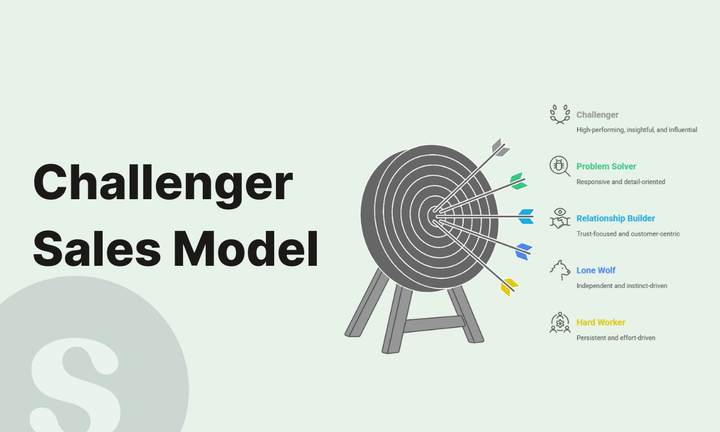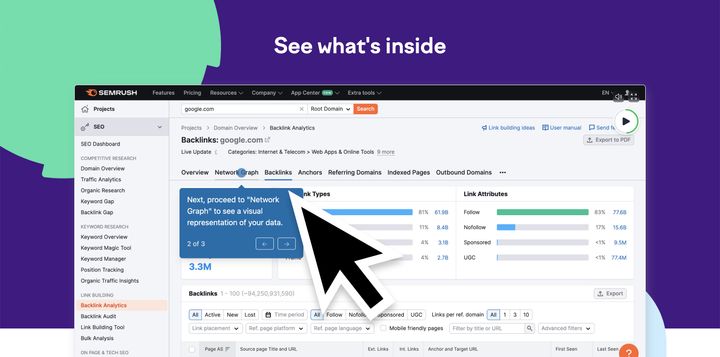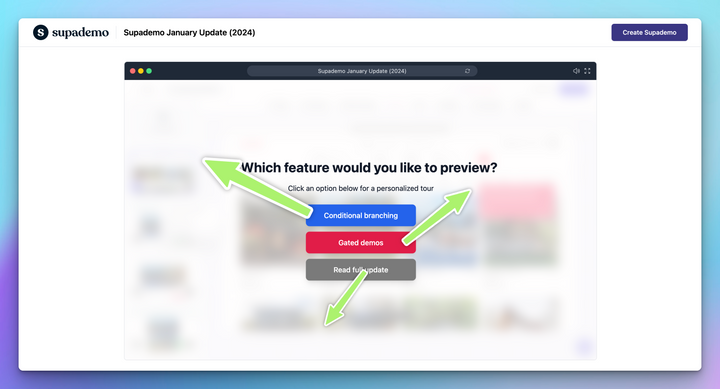Imagine walking into a deal where ten stakeholders have already researched your competitors.
They don’t need small talk; they need someone who will cut through noise, challenge assumptions, and show them what’s at stake.
This is the power of the challenger sales model. It transforms reps into trusted advisors who teach with insight, tailor with precision, and drive urgency.
In this article, we’ll explore the five rep profiles, the principles behind Challenger, and how to put it into action in 2025.
TL;DR
By applying its five-step framework and pairing it with modern tools like Supademo’s interactive demos, businesses can improve win rates, shorten sales cycles, and grow deal size.
What is the Challenger Sales Model?
The Challenger Sales Model is a sales methodology that prioritizes teaching customers something new, reframing how they view their problems, and confidently guiding them toward a solution.
It was introduced in 2011 through the bestselling book The Challenger Sale by Matthew Dixon and Brent Adamson, based on research of thousands of B2B reps by CEB (now Gartner).
The findings showed that relationship builders weren’t the top performers. Instead, reps who challenged assumptions and shared new insights consistently outperformed in complex sales.
The challenger model disrupted traditional selling by moving from “build rapport first” to “teach, tailor, and take control,” redefining the salesperson’s role as a trusted advisor who drives change.
The five sales rep profiles in Challenger Sales
In The Challenger Sale, researchers identified five distinct types of sales reps. Each profile reflects a common selling style you’ll likely recognize in yourself or your team.

1. Hard worker
Hard workers put in long hours and grind through calls and follow-ups. They are resilient and rarely give up on a lead.
But in complex deals, persistence without insight is not enough. Buyers need guidance, not just effort, so hard workers often fall short of top performance.
2. Lone wolf
Lone wolves rely on instincts and independence. They close deals their own way and resist process or coaching.
Their results can be impressive, but they are unpredictable and difficult to scale across a team. Success depends on personal talent rather than a repeatable or teachable sales approach.
3. Relationship builder
Relationship builders prioritize trust and rapport. They are highly accessible, attentive, and focused on customer satisfaction. This works well for maintaining accounts or nurturing existing relationships.
However, in competitive or complex sales, friendliness and trust alone do not move deals forward. Buyers often demand fresh insights and new perspectives.
4. Problem solver
Problem solvers excel at responsiveness and detail. They resolve issues quickly and make sure customers feel supported. This builds loyalty but also makes them reactive.
By focusing mainly on fixing problems, they miss chances to lead conversations, challenge assumptions, and proactively create urgency around a solution.
5. Challenger
Challengers stand out because they bring new insights to every interaction. They tailor conversations to a buyer’s specific context and confidently guide the sales process.
By creating constructive tension, they push prospects to think differently. Research shows challengers consistently outperform all other profiles, especially in high-stakes, complex B2B sales.
Core principles of the Challenger Sales Methodology
Challenger reps win deals because they apply a distinct set of behaviors. These principles shift the sales conversation from being reactive and relationship-driven to being proactive and insight-led.
1. Teach
Sales reps who provide more than the benefits of taking action, but also the cost of inaction, are likely to drive a customer to make that kind of change.
~ Brent Adamson, Co-author of The Challenger Sales
Challengers bring insights that customers haven’t considered. Instead of pitching products, they educate buyers on overlooked risks or opportunities.
By reframing how prospects think about their problems, they establish credibility and differentiate themselves. Teaching is less about features and more about changing the customer’s perspective.
2. Tailor
Every buyer has different priorities, pressures, and goals. Challengers adapt their message to match the customer’s industry, role, and business context.
This tailoring makes the conversation relevant and impactful. It shows the rep understands the customer’s world and positions the solution as uniquely suited to their situation.
3. Take control
Challengers do not wait for buyers to dictate the pace. They confidently guide conversations, push for next steps, and address objections head-on.
Taking control is not about being aggressive but about showing conviction. When handled well, it builds trust and keeps deals moving forward.
4. Create constructive tension
The most powerful Challenger skill is creating tension that motivates change. By challenging assumptions and highlighting the cost of inaction, reps make buyers uncomfortable with the status quo.
Renowned sales expert Josh Braun explains how to challenge the status quo by replacing pitching with curiosity, uncovering problems, and creating openings.
The tension is constructive because it sparks urgency without being confrontational, encouraging buyers to act sooner rather than later.
How to put the Challenger Sales Framework into action?
The challenger sales model is not a theory alone. It translates into a repeatable process that any rep can apply in real conversations. Here’s how to bring it to life.
1. Warm up with insights
Start by sharing knowledge about the buyer’s industry, market, or role-specific challenges. This proves you’ve done your homework and earns credibility.
"Approach each customer with the idea of helping him or her to solve a problem or achieve a goal, not of selling a product or service."
~ Brian Tracy, Sales thought leader
The goal is to spark curiosity with insights, not to pitch your product. For example: “I noticed compliance costs are rising 20% across your industry. How are you managing that internally?”
2. Reframe the buyer’s thinking
Once you’ve established credibility, shift the buyer’s perspective. Show them why the problem they thought was manageable is actually riskier or more urgent.
For example: “You already spend on security tools, but most firms under-invest in the integration piece. That gap often causes far more downtime than weak components themselves.”
This reframe challenges their assumptions and positions you as a trusted advisor. It should feel like a lightbulb moment, not a lecture.
3. Use emotional impact stories
Logic alone rarely drives change. To create urgency, connect your insights to real-world consequences. Tell a story about a customer who faced similar challenges and highlight what was at stake.
You could say something like “One customer ignored that integration issue until a data error cost them $250K in penalties. They told me they wished they’d faced it earlier.”
Emotional impact makes the problem feel immediate and personal, which motivates the buyer to act.
4. Deliver value before pitching your solution
Resist the urge to jump straight to your product. Instead, highlight the value of addressing the problem, with or without you.
Think along lines like “Even if you don’t use us, cleaning up those integration gaps often yields a 15–25% boost in system uptime. That’s worth thinking about.”
This builds trust and frames the conversation around outcomes. When buyers see you care about solving their issue, they are more open to hearing how your solution fits.
5. Introduce your product
Only after you’ve taught, reframed, and built urgency should you bring your product into the conversation. At this stage, the buyer should already see the need for change. Your job is to connect the dots between the problem you’ve highlighted and the solution you offer.
For example: “Because you already have those major tools, our system plugs in and handles the sync automatically, eliminating that very risk we just discussed.”
You can make this moment sharper with an interactive demo. Research shows that interactive demo videos get 300% more engagement.
👉 Learn more about how sales teams are improving efficiency with interactive demos in the State of Interactive Demos 2026 report.
With Supademo, you can send prospects a quick, click-through experience that highlights exactly how your product solves the issues you just reframed.
How can your business benefit from adopting challenger sales?
What would it mean if your team could close more complex deals, shorten sales cycles, and grow average deal size? That’s the promise of the challenger sales model.
But here’s the reality: most B2B purchases now involve 5–11 stakeholders across multiple functions. With so many perspectives in play, decisions drag on and deals stall. This is exactly where challenger selling makes a difference.
Instead of waiting for consensus to form, challenger reps create it. They reframe problems in ways that speak to every stakeholder, highlight the cost of inaction, and build urgency to act. The result is faster decisions, larger deals, and greater trust in your team’s expertise.
By adopting challenger selling, businesses can:
- Win more competitive, multi-stakeholder deals
- Speed up decisions by reducing buyer indecision
- Grow deal size by connecting solutions to broader business impact
- Earn credibility through insights, not just relationships
Why Challenger Sales outperforms other sales models?
There are plenty of sales methodologies out there. SPIN, MEDDIC, Solution Selling, and Consultative Selling all have their strengths, but they were built for different times and different buyer expectations.
Challenger stands apart because it is designed for today’s complex, multi-stakeholder deals.
| Sales model | Core idea | Strengths | Limitations | Best fit |
| Challenger | Teach, tailor, and take control by reframing buyer problems and creating urgency. | Effective in complex B2B sales; builds credibility through insight; creates consensus across multiple stakeholders. | Requires strong training and coaching; not as effective in simple or transactional sales. | Enterprise and mid-market B2B with long cycles. |
| SPIN Selling | Uses questions around Situation, Problem, Implication, and Need-payoff to uncover buyer needs. | Great for discovery and guiding prospects to self-diagnose problems. | Can be slow; less effective when buyers are already well-informed. | Mid-level deals where discovery is critical. |
| MEDDIC | Focuses on Metrics, Economic buyer, Decision criteria, Decision process, Identify pain, and Champion. | Strong qualification framework; helps forecast accuracy. | Doesn’t give reps tools to shape the deal; more about qualification than persuasion. | Enterprise deals with long, complex approval processes. |
| Solution Selling | Positions the product as a tailored solution to customer pain points. | Works well when buyers lack clarity on solutions; encourages customization. | Buyers today often research solutions before meeting sales; risks sounding generic. | Industries where buyers need guidance on solutions. |
| Consultative Selling | Builds relationships through deep understanding and advisory conversations. | Builds trust and long-term partnerships. | Overemphasis on relationships can slow decisions; less effective in competitive or fast-moving deals. | Services, professional consulting, account expansion. |
Challenge the way you sell today
The challenger sales model was built for complexity — and complexity is exactly what defines B2B sales in 2025. Buyers do deep research, involve more stakeholders, and expect proof earlier in the process.
To stand out, you need to teach, reframe, and guide prospects with experiences tailored to their challenges. That means moving beyond long decks and demo calls, and giving buyers a way to explore your solution hands-on when their curiosity is highest.
With interactive demo software like Supademo, you can build personalized, click-through demos in minutes. Reps can align these demos with the challenges surfaced in a Challenger conversation, so prospects not only hear the solution but experience it. Built-in Analytics show which features caught attention and which stakeholders engaged, helping you refine your pitch deal after deal.
The sales landscape has changed. Now it is your turn to challenge how you sell.
Try Supademo today and see how interactive demos bring the challenger sales model to life.
FAQs
What is the challenger model of sales?
The challenger sales model is a method where reps teach new insights, tailor messages to buyer needs, and take control of conversations. It pushes prospects to think differently and creates urgency, making it effective for complex B2B deals.
What are the 5 types of Challenger sales model?
The Challenger research identified five rep profiles: Hard Worker, Lone Wolf, Relationship Builder, Problem Solver, and Challenger. Among these, challengers consistently outperform others in complex sales because they educate buyers, challenge assumptions, and guide decisions with confidence and insight.
What is the challenger sales personality type?
A challenger seller thrives on bringing new ideas, tailoring conversations, and confidently leading the buying process. They use constructive tension to push prospects out of comfort zones, helping them see problems differently and inspiring faster, better business decisions.
Is the Challenger sale still relevant?
Yes. Today buyers research independently and involve multiple stakeholders. The challenger model remains effective because it helps reps stand out with insights, build consensus across committees, and create urgency. It directly addresses today’s long, complex B2B sales cycles.
How can interactive demos support challenger selling?
Interactive demos align perfectly with the challenger approach. Tools like Supademo let reps pair demos with the challenges uncovered in conversations, so prospects not only hear about solutions but experience them firsthand.




